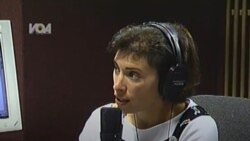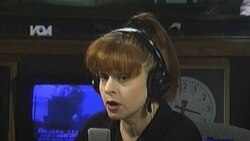September 11th, 2001 dawned bright and beautiful in Washington. Alas, it was a weekday, a work day. Employees of the Voice of America’s Central News division reported for their shifts, but the contrast between their cluttered, dusty newsroom and conditions outside could not be greater. Writer Jeff Custer remembers: “It was a gorgeous, gorgeous day, it was 70-something degrees outside, no humidity. It was like, ‘Why I am I going to work?’”
Once inside the third-floor newsroom, staffers settled in for what shaped up as a quiet morning. President George W. Bush was visiting an elementary school in Florida to promote his education plan. The list of top stories prepared by overnight editor Lou House included items out of Israel, Russia, China, Iraq – a little bit of everything. People were sitting at their desks, sipping Starbucks, working on stories ... when pictures of a giant steel tower belching smoke suddenly filled every TV screen in the room.
The day ceased to be quiet. Al-Qaida had launched its terrorist attacks on the United States.
As people stared at the TVs, newsroom managing editor Diane Bradley walked over to a regional desk editor, Don Benson, and asked if he was free to write a news bulletin. Benson typed out a three-line story that was quickly released on VOA’s internal wires for broadcast.
CN-041 URGENT **********
A commercial plane has crashed into New York's World Trade Center. Pictures of the crash, shown on Cable News Network, show smoke coming from one of the top stories of the building. The plane is reportedly embedded in the building. ## (cnn) nd/dlb
Russ Woodgates, an anchor on the radio program VOA News Now, broke the news to listeners this way: “Leading the news this hour,” he said, “a bizarre incident in the middle of Manhattan island, as a commercial jet apparently crashes into one of the world's tallest buildings, the World Trade Center."
For most in the newsroom, urgency did not immediately morph into full-fledged alarm. “When the first plane hit, there was speculation that it was a small plane, had trouble and it got off course,” says Benson. “That was the commentary, maybe this is a case like that, where the pilot had a heart attack or something like that.”
Many people in the newsroom had doubts, however. “The speculation was that this was an accident,” remembers Custer. “I took that at face value, we’re all working with that, but it was a weird thing. I was looking at the hole, and I thought that’s an awful big hole for a commuter plane.”
Washington correspondent Jim Malone was chatting with assignments editor Jack Payton. “We were watching live coverage after the first plane hit, discussing it, trying to assess what it meant. I said to Jack, ‘I think this is terrorism, and that bin Laden is behind it.’ I was just postulating, not asserting. As we discussed it, the second plane hit, and he turned to me and said ‘Maybe you’re right.’”
‘Only report facts’
CN-044 URGENT **********
Both towers of New York's famed World Trade Center are on fire, after a medium-size commercial jet struck one of the towers, and what appeared to be another plane struck the other tower. (cnn,WNBC) ND/dlb/DC
That update hit VOA’s wires a few minutes after another large passenger plane smashed into the Trade Center’s south tower at 9:03 a.m. The crash provoked a visceral reaction among all who watched. Susan Yackee, a News Now anchor, remembers hearing “a lot of gasps, a lot of ‘Oh my Gods,’ ‘Oh no’s’ and ‘It’s a terrorist attack.’ That kind of confirmed it for all of us. We had to jump into action right quick.”
Debbie Cooper was the chief editor on duty that morning, overseeing the flow of stories as the attacks unfolded. She has a distinct memory of when the second plane hit. “I remember turning to the desk, and said something to the effect of “This is probably the biggest story of our careers.’ It still is, isn’t it?”
Quickly, VOA's managers directed all staff and programs to focus on the attacks. In a corner of the newsroom, Benson and two writers – Lou Lorscheider and John Torrini – concentrated on sifting through the deluge of information and updating the main story, for use on VOA’s website and by the agency’s forty-plus language services.
On News Now, normally an orderly affair built around pre-recorded news features, producers made the decision to let 9 a.m. anchors Woodgates and Barbara Klein do an all-live program. The office of VOA’s New York bureau had a direct view of the World Trade Center towers. The News Now team was able to get New York staff member Diane Murrell on the phone and put her on the air. “The first tower is on fire,” she reported. “There is a gaping hole where the plane entered, which is facing me with flames coming out. Where the second plane just hit, that whole side is on fire all the way around.”
Amid the fast-breaking news, Klein says the News Now team, led that morning by editor Dick Snyder, did their best to stay away both from conjecture or unwarranted certainty. From the start, the anchors were careful to label the dual plane crashes an “apparent” terrorist attack and treat witness accounts as less than definitive. “We had to be very, very careful about everything we were saying, trying to remind whoever was listening that these are first person accounts of what people believe they saw,” Klein says.
Newsroom writers and editors exercised similar restraint. Early stories reported the FBI was investigating whether the planes had been hijacked, but refrained from saying who might be responsible. “As I recall, we made a conscious decision to write ‘unidentified planes went into the towers,’” Cooper says. “There were no other facts. We warned against any kind of speculation in those stories, for fear of being wrong. Only report facts, don’t suggest anything else is going on, follow the two sources rule, and the sources better be good.”
For the most part, everyone stayed calm, though the images coming out of lower Manhattan made that difficult. “It was very gruesome, because we would see people jumping out of the windows,” says Yackee. “It made you want to cry. I was thinking, what kind of evil could do this?”
Klein, on the air, had the even harder job of maintaining her composure while informing radio listeners of the catastrophes unfolding. “You’re trying to contain an earthquake inside you,” she says.
At the White House, things were the opposite of calm, remembers VOA’s correspondent there, Paula Wolfson. Not long after the second plane hit, the Secret Service ordered everyone in the West Wing to evacuate. "I was on the phone to VOA when agents showed up at my door,” says Wolfson. “There was a knock on the door, a Secret Service agent was there, he says, ‘Ma’am you have to get out of here.’ I said, ‘What?’ He said, ‘Ma’am, you gotta get out of here. Run!’ He literally picked me up by my shoulders, and I ran. It all happened very fast... When the Secret Service screams at you, you run, you don’t walk.”
The White House told the press corps to gather outside a nearby building – then left them there, isolated from the world at large. “We had little flip-phones.... but they weren’t working because so many people were trying to reach work and their families, and circuits were overloaded. Nobody could get through. It was probably the most frustrating morning of my life,” Wolfson says.
While Wolfson was cut off from the news, another newsroom staffer was about to feel it in his bones. Sam Verma, then a writer on the overnight shift, had returned home that morning to his apartment building in Arlington, Virginia, about one mile from the Pentagon. He was in sitting in his 10th-floor apartment, watching coverage of the attacks, when he felt vibrations around 9:35 am. “I had these huge windows, and they started rattling; I thought they were gonna break. The whole apartment was shaking,” he says.
Verma says he didn’t hear a blast, but the TV soon told him what he had felt: a hijacked plane, flying low over Arlington, had crashed into the Pentagon. In the News Now studio, Woodgates muttered an audible “Oh my,” before announcing that smoke and flames were rising from the massive U.S. military headquarters.
‘Everybody was scared’
After the Pentagon attack, intensity in the newsroom began to turn to anxiety. By now it was clear that a terrorist group was attacking centers of U.S. power, and it wasn’t hard to imagine hijackers slamming an airliner into the U.S. Capitol, a three-minute walk away from the VOA building on Washington’s Independence Avenue. Some in the newsroom grew uneasy.
“A couple of people in the newsroom who were freaking out wanted to leave,” says Benson. “I don’t think anybody left but there was a lot of fear, it was very tense. They were told by Diane [Bradley], if you need to leave, leave. Everybody was scared. We had windows behind us and you just make things up in your mind – are snipers going to open fire? But everybody kept at it.”
Jeff Custer recalls that when the first World Trade Center tower collapsed, “there was an audible groan. There was disbelief. It may have been me! But I think it was more than one person. People kept working but it was deadly quiet, and then it was just fingers on keyboards.”
“I felt we were really doing a fine job,” says Cooper. “We were being extraordinarily accurate. Rapidly, getting out fact after fact, one after the next. The adrenaline was flowing for everybody. There were lots of reaction stories too. I just felt very proud of everybody in the newsroom that day.”
As shifts ended that afternoon, VOA employees left work to an unfamiliar scene. The capital had rapidly emptied out after the attacks, and the usually bustling streets around the VOA building were nearly devoid of car and foot traffic. And, “the planes had stopped flying over,” notes another News Now anchor, Sarah Williams. “It was eerie how quiet it was.”
It was still a beautiful day, just one that nobody could enjoy.








